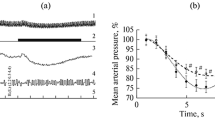Abstract
Evoked potentials in response to a combination of electrostimulation of both anterior extremities were investigated under conditions of a chronic experiment on monkeys in the head of the caudate nucleus and frontal and somatosensory cortex. Three types of interaction of afferent volleys evoked by spontaneous stimulation were noted: facilitation, summation, and depression. A high degree of correlation of the responses in the head of the caudate nucleus with the responses in the frontal cortex was noted. The role of the frontal and somatosensory cortex in the formation of sensory responses in the caudate nucleus is compared.
Similar content being viewed by others
Literature cited
S. M. Butkhuzi, Electrophysiological Investigation of Functions of the Caudate Nucleus [in Russian], Izd. Metsniereba, Tbilisi (1971).
A. M. Ivanitskii, Brain Mechanisms of Signal Evaluation [in Russian], Izd. Meditsina (1976).
A. I. Maramyan, B. F. Tolkunov, and G. A. Oganesyan, “Organization of cortico-striatal relations in rats and monkeys,” Zh. Vyssh. Nervn. Deyat.,22, No. 4, 858–867 (1972).
L. V. Lobanova and S. I. Smirnov, “Participation of visceral signaling in the integrative function of the caudate nucleus,” in: The Nervous System. Problems of Neurophysiology [in Russian], Vol. 20, Izd. LGU (1978), pp. 29–38.
B. F. Tolkunov, “Corticofugal influences on somatic afferentation of the monkey caudate nucleus,” Dokl. Akad. Nauk SSSR,205, No. 5, 1261–1264 (1972).
B. F. Tolkunov, The Striatum and Sensory Specialization of the Neuronal Network [in Russian], Izd. Nauka, Leningrad (L978).
B. F. Tokunov and G. A. Oganesyan, “Participation of a corticofugal message in the formation of somatic evoked potentials in the monkey caudate nucleus,” Neirofiziologiya,10, No. 1, 95–98 (1978).
D. A. Farber, “Specificity of so-called nonspecific visual evoked potentials,” in: Basic Problems of Electrophysiology of the Brain [in Russian], Nauka, Moscow (1974), pp. 222–235.
C. Shagass, Evoked Brain Potentials in Psychiatry, Plenum, New York (1972).
J. Astruc, “Corticofugal connections of area 8 (frontal eye field) inMacaca mulatta,” Brain Res.,33, No. 2, 241–256 (1971).
K. Kemp and T. F. S. Powell, “The cortico-striatal projection in the monkey.” Brain,93, No. 3, 525–546 (1970).
S. L. Liles, “Cortico-striatal evoked potentials in the monkey (Macaca mulatta),” EEG Clin. Neurophysiol.,38, No. 2, 121–129 (1975).
G. Pouderoux and E. Freton, “Patterns of unit responses to visual stimuli in the cat caudate nucleus under chloralose anesthesia,” Neurosci. Lett.,11, No. 1, 53–58 (1979).
R. S. Snider and J. C. Lee, A Sterotaxic Atlas of the Monkey Brain (Macaca mulatta), Chicago (1961).
Author information
Authors and Affiliations
Additional information
Translated from Fiziologicheskii Zhurnal SSSR imeni I. M. Sechenova, Vol. 69, No. 2, pp. 161–166, February, 1983.
Rights and permissions
About this article
Cite this article
Oganesyan, G.A., Tolkunov, B.F. Cortico-striatal relations under conditions of interaction of monomodal afferent volleys. Neurosci Behav Physiol 15, 304–309 (1985). https://doi.org/10.1007/BF01185292
Received:
Issue Date:
DOI: https://doi.org/10.1007/BF01185292



